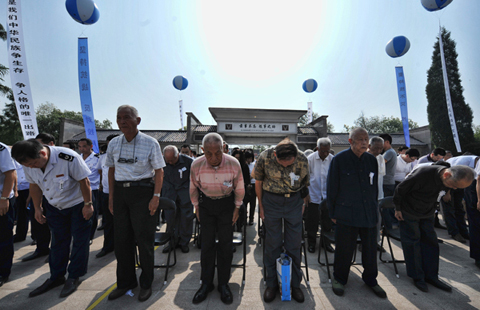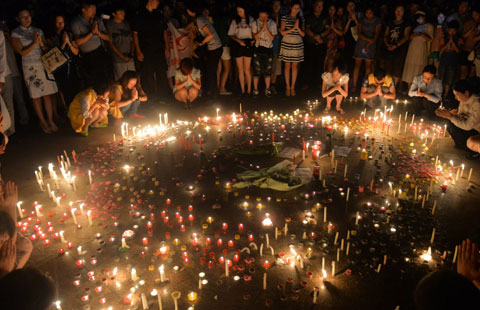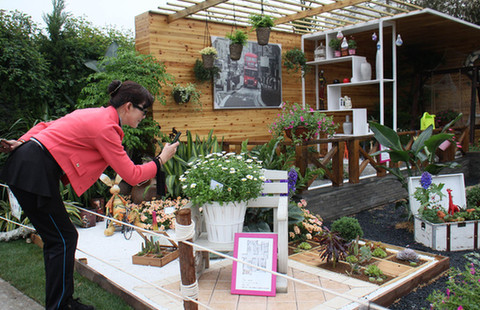Photos depict China during Japan's invasion
Updated: 2014-09-03 09:09
By Xinhua in Chongqing(China Daily)
|
|||||||||||
A Chinese cultural organization has amassed a collection of 50,000 photos from newspapers, libraries and museums portraying the hardships that Chinese people endured during the War of Resistance against Japanese Aggression (1937-45).
The photos were gathered over three years by Hongyanlianxian, a government-funded culture organization in Chongqing, from all over the world. A third of the photos will be made public for the first time.
Li Hua, the project organizer, said the collection will reveal a country full of people determined to help their nation achieve victory. The photos, showing both civilians and military personnel fighting for China, present real-life stories of sacrifice and struggle from more than 60 years ago.
When war broke out in 1937, China quickly lost much of its coastal industrial bases to Japan. As a result, military production dropped dramatically and most of China's navy ships were destroyed.
But in the hopes of reviving military production, the nation relocated its industrial production facilities to the unoccupied western part of the country. Many industrial facilities and materials were transferred to Yichang, Hubei province, to be transported on the Yangtze River to safer cities in western China.
The photo collection shows how Lu Zuofu, at the time a Chinese shipping magnate, rose to the occasion. He personally donated his company's ships to help in the transportation of the country's industrial facilities and materials. It took 60 days for Lu's ships to transfer materials up the river.
When Japanese troops finally seized Yichang, the invaders took over a virtually empty city. Most of the important material and production equipment had been rushed westward.
The collection also highlights the life of Chinese educator Tao Xingzhi, who moved his Yucai School to a mountainous village near Chongqing after Japan's air force bombed the wartime capital.
Many of the photos depict the hardships that Tao, his teachers and students endured at the school, located in a Buddhist temple called Gusheng.
Yang Xinglian, who was then a student at the school, said life in the old temple was tough. While its remote location kept the school safe from Japan's bombs, it also brought great inconvenience. It took several hours for teachers and lecturers to walk to and from the city. Getting water was an arduous task, requiring long walks carrying buckets.
Despite the hardships, the school enrolled more than 600 children during its seven years at the temple. It offered a variety of classes to its students, from courses on international affairs to dancing.
The photo collection also highlights a number of military heroes, including Zhao Yiman, a female soldier who became known for not yielding under extremely cruel torture. She was later murdered.
There are also photos of the war's survivors. One set is of Long Qiming, a Flying Tigers pilot who served with the group of US volunteer pilots sent secretly to Asia by then-president Franklin D. Roosevelt before the US entered World War II. They joined a Chinese air force organized by Claire Lee Chennault, a retired US Army colonel.
An estimated 1,500 Flying Tigers members and 900 Chinese airmen who fought along with Long died in the war.
China recently named Sept 3 as Victory Day to commemorate the Chinese hardships and struggles during the War of Resistance against Japanese Aggression.
A book containing the recently discovered photos will be published before Victory Day 2015.
Related Stories
Chinese leaders to commemorate anti-Japan war victory 2014-09-01 21:53
Anti-Japan war anniversary makes 2015 very meaningful: Park 2014-07-04 20:31
China publishes sites, heroes commemorating Anti-Japanese War 2014-09-01 19:23
Anti-Japanese War archives cover defense of Nanking 2014-09-01 18:37
Today's Top News
China lays down plan for cross-border rail lines
China Mobile ringing up sales for iPhone 6
Hotline helps nationals overseas
New page turner
South Korea regrets over laser pen incident
Nude shots removed from websites
'Bad news' for pregnant giant panda
Vice-premier vows to advance modern Silk Road
Hot Topics
Lunar probe , China growth forecasts, Emission rules get tougher, China seen through 'colored lens', International board,
Editor's Picks

|

|

|

|

|

|





